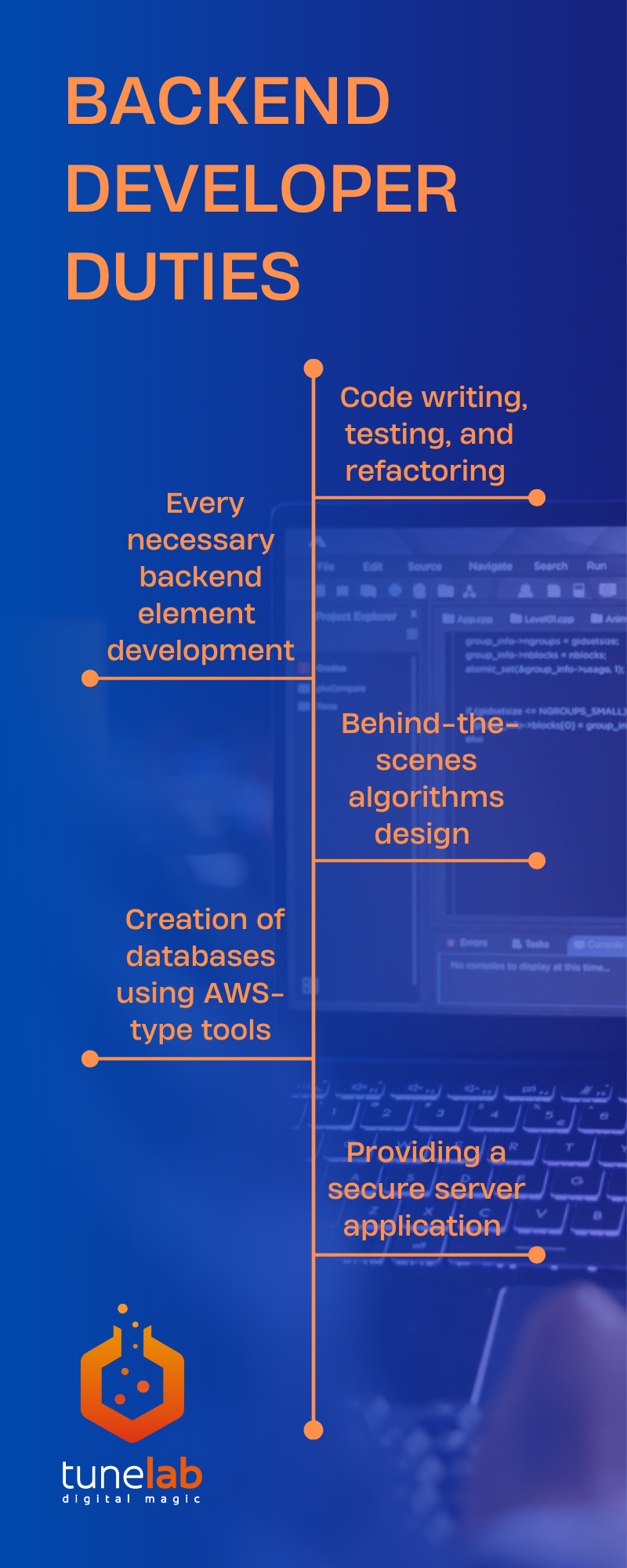Backend development is a web development field responsible for creating the server part of a web application, which provides all the app’s main processes behind the scenes. Frontend and backend must be combined and work harmoniously to ensure optimal functionality of the web solution and satisfy the client’s needs.
The successful operation of the backend is ensured by databases, frameworks, and APIs, which we will discuss in more detail in a new blog post. We will also talk in more detail about the main responsibilities of the backend developer, who provides a high-quality backend, and combination with the frontend.
The Role of Backend Developers in Modern Tech
Speaking about the cooperation of the backend developer with the client, there are several key criteria. First, it is a well-written technical task that will allow the developer to navigate the given task better and spend less time on additional meetings. Second, even with a well-written work plan, both the developer and the customer must consider all the major risks and pitfalls that may arise during development. If the company uses the Scrum methodology, the possible risk calculation will allow you to think of backup plans and think about additional time and finances to solve a problem that may arise and delay development.

Backend development responsibilities include the following:
- Code writing, testing, and refactoring;
- Development of every necessary backend element on a server;
- Designing the required architecture of behind-the-scenes algorithms;
- Creation of databases using AWS-type tools;
- Providing a secure server application that can be easily maintained and updated.
In addition, for successful backend development, a developer must be well-versed in a set of tools, which we will mention in the following paragraphs.
Decoding the Top Backend Languages
Among the most popular programming languages for backend development, there can be mentioned PHP, Python, Java, Ruby, Node.js, and others. Python is common in backend development because it is a high-level programming language whose purpose is increasing developer productivity, readability, and code quality. Java (not to be confused with Java Script) is another object-oriented programming language designed for writing client-side applications and server-side software. In turn, the high-level language for the Ruby backend is designed for simple and productive programming of applications and software.
Our specialists develop the lion’s share of modern web solutions with PHP backend language. We use it mainly because it is open source, works on almost any operating system, supports cross-platform, and is easy for developers to use. In particular, based on PHP, we often use Laravel, which you can read more about in one of our previous blog posts.
JavaScript Beyond the Frontend
Although JavaScript is considered one of the most popular front-end programming languages, it is sometimes used for back-end programming. This is because the syntax of this language is quite close to the syntax of the already mentioned Java, C and C#.
It is worth mentioning that the Node.JS backend framework is based on JavaScript, which allows developers to create applications and web solutions with a powerful server with dynamic web pages and convenient creation and management of databases.
Top Tools for Backend Developers
Frameworks (Laravel)
PHP-based Laravel is probably the most popular framework our developers use for the backend. This framework allows you to quickly develop a reliable backend, has several ready-made solutions, and contains options for easy scalability of the backend according to the project (it is suitable for both large-scale web solutions and smaller web applications). Laravel allows you to save the number of lines of code, removes duplication of already written code, and forms an already generally accepted app structure, which facilitates development for the backend developers themselves.
You can read more about Laravel and its interaction with Vue in our previous posts.
Git Tools
To track the process of writing code, making changes to it, and fragmenting the development, there are Git tools. In particular, these are GitLab and GitHub. Both tools have a similar working principle: both have a set of tools for team collaboration, task management, bug solving, and tracking.
Docker Compose
Docker Compose is a tool that greatly simplifies and synchronizes the working environment for the backend development team. If a web solution backend is developed on Windows, then Docker Compose allows a group of servers to simulate work on this operating system and gives developers access to the same set of functionalities.
SQL and Databases
SQL (Structured Query Language) is a declarative programming language used to create, modify, and manage databases. First, with the help of SQL, you can create, change, and manage databases (adding, storing, deleting, etc.). Also, you can perform complex operations with data, including grouping, filtering, sorting in tables, and other types of information processing. In addition, with the help of SQL, developers can separately provide different users with different levels of access to information, which ensures information protection from unnecessary interventions.
In particular, the most common SQL-based database management systems are MySQL and PostgreSQL. Both systems have open-source code and are flexible, reliable, and have high processing speed. Read more about these systems in one of our previous articles.
Redis
Redis is an open-source NoSQL database management system. This system stores databases in RAM and includes mechanisms for saving information on disks and other physical storage devices. Commonly used for caching and speeding up data transfer, supports execution of a batch of commands and retrieval of a batch of results.
Redis supports Linux and Mac OS X operating systems, and programming languages such as JavaScript, PHP, Python, Ruby, and others.
The Choreography of Backend and Frontend Development
The backend interacts with the front end depending on the type of application being developed. We’ll discuss this interaction, using examples of SPA and MPA.
In a single-page application (SPA), the frontend and backend are combined using REST, SOAP, and GraphQL. The first one is an approach to the architecture of HTTP-based network protocols that provide access to information resources. REST provides the process of sending requests to the server by the frontend, and the backend sends responses in JSON or XML format. The first format is text-based and more lightweight, so it is often used in single-page applications, while XML is more difficult to process and bulky. SOAP is a protocol for exchanging data between the front end and the back end, but again, due to its complexity, it is rarely used in single-page solutions. GraphQL, in turn, is an open-source querying and data manipulation language for APIs.
As for multi-page applications (MPA), the frontend-backend interaction usually occurs thanks to the HTML language. This interaction occurs by retrieving HTML pages from the backend after each request for a new page.
Backend development is a successful web project’s key component, providing reliable and efficient servers with secure databases. In addition, the back end must be harmoniously united with the front end and work harmoniously with it. To create a quality backend, a developer must have a set of tools, programming languages, frameworks, etc. that handles requests and provides access to data, ensuring excellent performance and reliability.
Backend development in the creation of various web solutions is difficult to overestimate. Competent developers and effective tools depend on the speed, and efficiency of applications, as well as their security and scalability. These components ensure a successful backend in the project, which will work for a long time and without interruption and fulfill the needs of the client and the customer.


